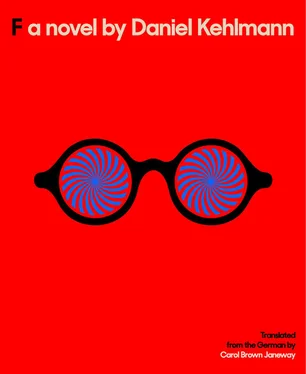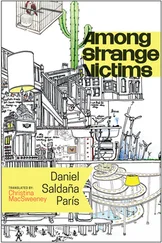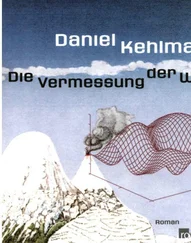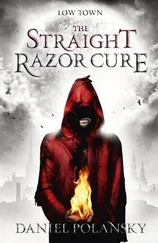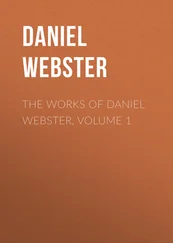No one knows about this studio, no one can connect me to it. It wasn’t me who bought it, but a firm that belongs to another firm that is based in the Cayman Islands and in turn belongs to me. If anyone were to inspect the land registers, they wouldn’t find my name. It would take a great deal of time and effort to keep digging until they found me. The property taxes, heating, water and electricity bills are handled automatically by a numbered account in Liechtenstein. Whistling to myself, I hang up my jacket, roll up my sleeves, and put on my overalls. A dozen paintings are leaning against the wall, covered by a cloth, and in front of them is one that’s almost finished on the easel.
Luckily I have no need of glasses; my eyesight is as sharp as it ever was. Born to see, appointed to look. So I stand in front of the picture and contemplate it. A village square in a little French town. In the center a gaudy sculpture, clearly by Niki de Saint Phalle: an outsized, brightly colored female figure holding her arms in the air. The sky is cloudless. At the edge of the square, children with bicycles are clustered around a small boy who is holding his head in his hands and crying. A woman is looking out a window. Her mouth is wide open — she’s calling someone. A man in a parked car is looking up at her threateningly. There’s a dark puddle at the edge of the square that may or may not be blood. A dachshund is drinking from it. Something terrible has happened and the people seem to be wanting to cover it up. If you were to look a little longer, hunt a little better for clues, you’d be able to figure it out, or at least you think so. But if you step back, the details disappear and all that remains is a colorful street scene: bright, cheerful, full of life. Large posters advertise beer, cheese spread, and various brands of cigarettes in the style of the early seventies.
I work in silence, sometimes aware of my own whistling. Only a few details are still missing. The quiet of the studio surrounds me like a solid substance. The noise of the city doesn’t penetrate up here, and even the heat is blocked. It can continue like that for long stretches. When I think back on the hours of work, I can barely remember them — it’s as if they had been extinguished by my concentration.
Up here a couple of points of light to add, and down there a shadow to blur the features of the child. The number plate needs a fleck of rust. People need to be able to see the brushstrokes, thick, in the style of the Old Masters! And then the last point of light, an accent made up of white, ocher, and orange. I step back, lift the palette, take a little bit of black, and with a quick stroke add the date and signature in the corner: Heinrich Eulenboeck, 1974 .
When I was young, vain, and lacking all experience, I thought the art world was corrupt. Today I know that’s not true. The art world is full of lovable people, full of enthusiasts, full of longing and truth. It is art itself as a sacred principle that unfortunately doesn’t exist.
It doesn’t exist any more than God does, or the End of Days, or eternity, or the Heavenly Host. All that exists are works, different in style, in form, and in essence, and the whispered hurricane of opinions about them. And the changing names of these artists that with the passage of time get attached to the selfsame objects. There are not a few Rembrandts that were once considered to be the apogee of painting and that we now know to have been painted by hands other than his. Does this lessen them?
“Of course not!” the laymen cry zealously, but it’s not that simple. A picture is not that selfsame picture if it was made by someone else. A work is very closely linked with our image of who brought it into the world when, why, and driven by what impulse? A pupil who has acquired all his master’s skills and now paints like him still remains a pupil, and if van Gogh’s paintings had been made by an affluent gentleman a generation later, the same rank would not be accorded to them. Or would it?
Things really do get even more complicated. Who has heard of Emile Schuffenecker? And yet he painted numerous pictures for which we worship van Gogh. We’ve known this for some time, but has van Gogh’s reputation suffered as a result? Lots of van Goghs are not by van Gogh, Rembrandt’s paintings are not all by Rembrandt, and I’d be very surprised if every Picasso was a Picasso. I don’t know if I’m a forger; it depends, like everything in life, on how you define it. Nonetheless Eulenboeck’s most famous paintings, all the ones on which his reputation rests, were created by the same person, namely me. But I’m not proud of that. I haven’t changed my opinion: I’m not a painter. That my paintings are hanging in museums says nothing against the museums and nothing in favor of my pictures.
All museums are full of fakes. So what? The provenance of each and every thing in this world is uncertain; there’s no particular magic involved in art, and the works that are ranked as great have not been brushed by an angel’s wings. Art objects are objects just like everything else: some are extraordinarily accomplished, but none of them springs from a higher universe. That some are linked with the name of this or that person, that some of them fetch high prices and others don’t, that some are world-famous and most are not, is due to a number of different forces, but none of these is otherworldly. Nor do forgeries have to be successful to fulfill their purpose: perfect imitations can be unmasked while imperfect ones are hung on walls and admired. Forgers who are proud of their work overestimate the importance of well-grounded skill in exactly the same way as laypeople do: anyone who isn’t totally inept and makes the effort can learn a craft. It’s quite right that craft lost its importance within art, it makes sense that the idea behind a work became more important than the work itself; museums are sacred institutions that have outlived themselves, as the avant-garde has been saying for a long time now, with good reason.
But visitors to cities want somewhere to go when the afternoons are long, and without museums there would be a lot of blank pages in the travel guides. Because there have to be museums, they also have to exhibit things, and these things have to be objects, not ideas, just as collectors want to hang things, and pictures are better to hang on walls than ideas. Admittedly, an ironic free spirit once displayed a urinal in a museum to mock the institution and all its holy affectations and artistic pieties, but he also wanted money and honors and, above all, he wanted to be admired in the traditional way, and so a replica of the original still stands on its plinth, surrounded by holy affectations and artistic pieties. Although the theory that the museum has outlived itself is correct, the museum has in fact won, the urinal is exclaimed over, and as for the theory behind it, only students in their second semester still wonder about it.
I often think about the artists of the Middle Ages. They didn’t sign things, they were craftsmen who belonged to guilds, they were spared the disease that we call ambition. Can it still be done that way, can you still do the work without taking yourself seriously — can you still paint without being “a painter”? Anonymity is no help, it’s merely a clever hiding place, another form of vanity. But painting in the name of someone else is a possibility; it works. And what amazes me all over again every day is: it makes me happy.
The idea came to me already on the third day. Heinrich was asleep next to me, the sea was casting its reflections on the ceiling, and I suddenly realized how I could make him a famous painter. What distinguished him, what he lacked, what I had to do were all quite clear to me. He would be good on television and in magazine photos, and he would give wonderful interviews. The only drawback was those farmhouses. It was going to take diplomacy.
Читать дальше
